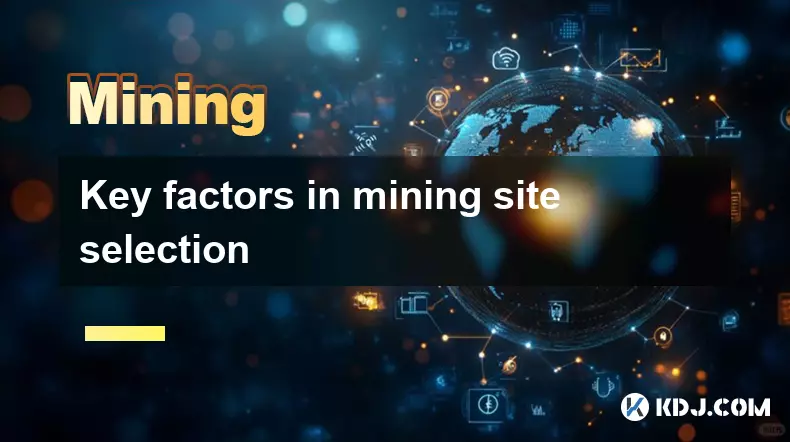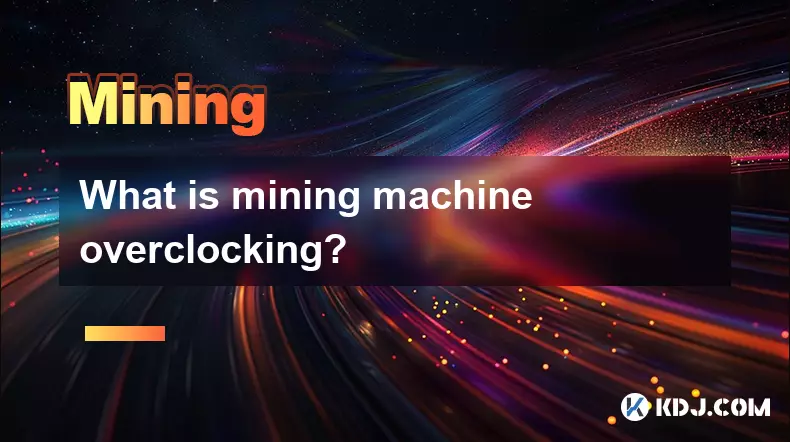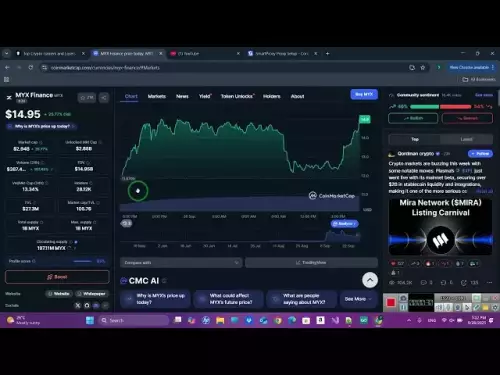-
 bitcoin
bitcoin $109547.008142 USD
0.04% -
 ethereum
ethereum $4011.838726 USD
-0.05% -
 tether
tether $1.000402 USD
-0.01% -
 xrp
xrp $2.798606 USD
0.88% -
 bnb
bnb $970.877944 USD
1.39% -
 solana
solana $202.237275 USD
-0.95% -
 usd-coin
usd-coin $0.999673 USD
0.00% -
 dogecoin
dogecoin $0.229294 USD
-1.15% -
 tron
tron $0.336370 USD
-0.45% -
 cardano
cardano $0.777260 USD
-1.66% -
 hyperliquid
hyperliquid $45.503019 USD
1.73% -
 ethena-usde
ethena-usde $1.000362 USD
0.01% -
 chainlink
chainlink $20.785303 USD
-1.10% -
 avalanche
avalanche $28.755822 USD
-0.11% -
 stellar
stellar $0.358303 USD
-0.48%
Key factors in mining site selection
Cooler climates, cheap renewable energy, and stable regulations in places like Iceland and Texas make ideal conditions for profitable, sustainable crypto mining operations.
Sep 27, 2025 at 06:00 am

Geographical and Climatic Advantages
1. Cooler climates significantly reduce the need for artificial cooling systems, which are costly to maintain in large-scale mining operations. Regions near polar areas or at high altitudes naturally offer lower ambient temperatures, helping to keep mining rigs within optimal thermal ranges.
2. Countries like Iceland, Canada, and parts of Russia have become hotspots for mining farms due to their cold weather patterns throughout much of the year. This natural advantage translates into longer hardware lifespans and reduced downtime caused by overheating.
3. Geographic stability is another critical aspect. Areas free from frequent earthquakes, floods, or hurricanes minimize the risk of physical damage to infrastructure. Stable terrain ensures uninterrupted power delivery and network connectivity, both vital for continuous mining activity.
4. Proximity to underutilized hydroelectric, geothermal, or wind energy sources often coincides with remote but climatically suitable regions. These renewable sources not only provide cost-effective electricity but also align with growing environmental concerns within the crypto industry.
Energy Cost and Availability
1. Electricity consumption constitutes over 90% of operational expenses in mining. Locations offering subsidized, low-cost, or surplus energy attract major mining enterprises seeking to maximize profit margins.
2. Countries such as Kazakhstan, Iran, and Venezuela have drawn attention due to government-subsidized electricity rates, enabling miners to operate thousands of ASIC units at minimal cost. However, political instability or regulatory crackdowns in these regions can offset financial benefits.
3. Access to off-peak energy grids allows miners to negotiate special tariffs during times of low demand. Some operators coordinate with local utilities to absorb excess generation, turning wasted energy into computational power.
4. Energy reliability matters just as much as price. Frequent blackouts or grid fluctuations can damage equipment and interrupt block validation processes. Stable national grids with backup generators or independent microgrids enhance operational continuity.
5. Miners increasingly partner with energy producers directly, especially in oil-rich regions where flared natural gas powers on-site data centers. This symbiotic relationship reduces emissions while providing cheap, dedicated power streams.
Regulatory and Political Environment
1. Clear legal frameworks around cryptocurrency mining encourage long-term investment. Jurisdictions that recognize digital assets as legitimate property and allow mining without heavy taxation foster innovation and infrastructure growth.
2. The United States, particularly states like Texas, offers a balanced mix of deregulated energy markets and supportive legislation, making it a preferred destination for institutional-grade mining facilities.
3. In contrast, countries like China have imposed outright bans, forcing operators to relocate en masse. Regulatory unpredictability creates volatility in site viability, prompting companies to diversify across multiple compliant regions.
4. Licensing requirements, capital controls, and restrictions on repatriating profits influence where mining firms establish headquarters or regional hubs. Transparent governance and ease of doing business rank high in decision-making criteria.
5. Local government incentives—such as tax holidays, land grants, or expedited permitting—can tip the balance when comparing otherwise similar locations. Public-private partnerships are emerging as a model for developing mining zones with shared infrastructure.
Infrastructure and Connectivity
1. High-speed internet with low latency is essential for synchronizing with blockchain networks. Delays in transaction propagation or block submission result in missed rewards and reduced efficiency.
2. Proximity to Tier-3 or Tier-4 data centers provides access to redundant fiber-optic lines and managed services. Mining pools often require stable upstream connections to coordinate hashing efforts across global participants.
3. Transportation networks matter for hardware logistics. Sites accessible by road, rail, or air facilitate faster deployment and maintenance of mining rigs, especially during scaling phases or emergency repairs.
4. On-site infrastructure including secure fencing, surveillance systems, fire suppression, and climate control determines how well a facility protects valuable equipment. Remote monitoring capabilities further reduce reliance on local personnel.
5. Scalability potential defines whether a location can accommodate future expansion. Land availability, zoning laws, and power line capacity must support incremental growth without triggering new regulatory hurdles.
Frequently Asked Questions
What role does internet speed play in mining profitability?Internet speed affects how quickly a miner receives updated blockchain data and broadcasts solved blocks. Even minor delays can cause orphaned blocks, leading to lost revenue. A stable, low-latency connection ensures consistent participation in consensus mechanisms.
Can residential areas be used for large-scale mining operations?Residential zones typically lack the electrical capacity and cooling infrastructure needed for industrial mining. Voltage fluctuations, limited bandwidth, and noise complaints make them unsuitable. Commercial or industrial zones better meet technical demands.
How do miners handle extreme weather conditions?In hot climates, miners deploy advanced liquid cooling systems, immersion tanks, or underground facilities to manage heat. In storm-prone areas, reinforced buildings and backup power supplies protect against outages and physical damage.
Is renewable energy mandatory for sustainable mining?While not mandatory, renewable energy usage improves public perception and reduces long-term costs. Solar, wind, and hydro-powered mines are increasingly favored by ESG-conscious investors and partners seeking carbon-neutral operations.
Disclaimer:info@kdj.com
The information provided is not trading advice. kdj.com does not assume any responsibility for any investments made based on the information provided in this article. Cryptocurrencies are highly volatile and it is highly recommended that you invest with caution after thorough research!
If you believe that the content used on this website infringes your copyright, please contact us immediately (info@kdj.com) and we will delete it promptly.
- Ripple, Shiba Inu, and Digitap: The Crypto Landscape in 2025
- 2025-09-28 23:05:12
- Crypto Portfolio Management: Riding the Whale Waves and Finding Gems
- 2025-09-28 22:45:14
- BTC Price Wobbles as Bitcoin ETFs See Inflows, Ethereum ETFs Bleed: What's the Deal?
- 2025-09-28 22:25:17
- DeepSnitch AI: The Meme Coin Alternative with 1000x Potential?
- 2025-09-28 22:45:14
- BlockchainFX, Solana, Dogecoin: Decoding the Crypto Shift
- 2025-09-28 23:05:12
- Crypto's Wild Ride: Dogecoin, AVAX, TRUMP, and the Newcomer MAGACOIN FINANCE
- 2025-09-28 23:10:01
Related knowledge

The difference between staking and mining
Sep 24,2025 at 05:18am
Understanding Staking in the Cryptocurrency Ecosystem1. Staking involves holding funds in a cryptocurrency wallet to support the operations of a block...

How to participate in testnet mining?
Sep 22,2025 at 09:18am
Understanding Testnet Mining in the Crypto Ecosystem1. Testnet mining is a method used by blockchain developers to simulate real-world conditions on a...

How to dispose of abandoned mining machines?
Sep 19,2025 at 08:19pm
Assessing the Condition of Abandoned Mining Rigs1. Begin by inspecting each mining machine for visible damage, corrosion, or missing components. Machi...

How to identify high-quality mining pools?
Sep 21,2025 at 03:19pm
Reputation and Track Record1. A mining pool’s reputation is built over time through consistent performance and transparency. Pools that have operated ...

Advantages of decentralized mining pools
Sep 20,2025 at 04:36pm
Enhanced Security and Resistance to Censorship1. Decentralized mining pools operate on blockchain-based smart contracts, eliminating the need for a ce...

What is mining machine overclocking?
Sep 21,2025 at 07:19pm
Understanding Mining Machine Overclocking1. Mining machine overclocking refers to the process of increasing the operating frequency of a cryptocurrenc...

The difference between staking and mining
Sep 24,2025 at 05:18am
Understanding Staking in the Cryptocurrency Ecosystem1. Staking involves holding funds in a cryptocurrency wallet to support the operations of a block...

How to participate in testnet mining?
Sep 22,2025 at 09:18am
Understanding Testnet Mining in the Crypto Ecosystem1. Testnet mining is a method used by blockchain developers to simulate real-world conditions on a...

How to dispose of abandoned mining machines?
Sep 19,2025 at 08:19pm
Assessing the Condition of Abandoned Mining Rigs1. Begin by inspecting each mining machine for visible damage, corrosion, or missing components. Machi...

How to identify high-quality mining pools?
Sep 21,2025 at 03:19pm
Reputation and Track Record1. A mining pool’s reputation is built over time through consistent performance and transparency. Pools that have operated ...

Advantages of decentralized mining pools
Sep 20,2025 at 04:36pm
Enhanced Security and Resistance to Censorship1. Decentralized mining pools operate on blockchain-based smart contracts, eliminating the need for a ce...

What is mining machine overclocking?
Sep 21,2025 at 07:19pm
Understanding Mining Machine Overclocking1. Mining machine overclocking refers to the process of increasing the operating frequency of a cryptocurrenc...
See all articles









































































